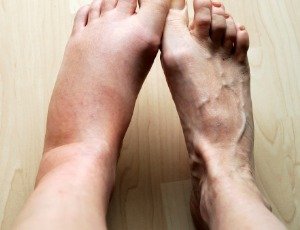4 Telltale Signs You Might Be Suffering From "Inflammaging"
In a hurry? Click here to read the Article Summary...
Growing older. It’s one of the few things that all human beings have in common – regardless of race, gender, socioeconomic status, or education level. There’s not a person on the planet who (while living), can escape its inevitable, youth-robbing clutches… or is there?
While it’s impossible for any individual to stay young forever, growing old doesn’t have to look the same for everyone. Some people seem to have been blessed with the joy of a more “graceful” transition into old age, while others tend to wear the physical evidence of a life long-lived far more prominently.
So, what’s to account for this apparent dichotomy in what it means to grow old? Is it all just a matter of random chance? Or are there identifiable factors at play that impact whether an aging person ends up looking eternally youthful for their age, or more like a character from The Walking Dead?
Inflammation Gone Awry: The Sworn Enemy of Healthy Aging
At a fundamental level, the human body is made up of trillions of tiny cells that are genetically programmed to keep a person as healthy and functional as possible. They’re able to do this by undergoing routine maintenance, meaning some cells reproduce to replace old, defunct ones, while others undergo varying degrees and cycles of restoration and overhaul on an as-needed basis.
The human body also has an innate immune system that oversees the maintenance of this system of cellular health. One of your immune system’s core responsibilities is to send out repair crews to take care of any problems that might arise.
This critical immune response is better known as inflammation – and without it, you wouldn’t live very long.
Whenever you injure yourself or contract an infection, for instance, inflammation rises to the occasion and takes care of it as quickly and efficiently as possible. Its effects might manifest as swelling or redness at the site of a wound, or perhaps a fever if the damage is internal and systemic.

Acute Inflammation: The “Good” Kind of Inflammation
This short-term, or acute, response by the immune system to an invading threat is completely normal and necessary to maintain life.
It’s a natural biological response by the body to any harmful stimuli that it encounters. It often involves repairing or removing old and damaged cells, clearing out disease-causing pathogens, or simply restoring balance to the immune system itself [1].
In other words, the purpose of inflammation is to heal the body, not to harm it.
This type of acute, or transient, inflammation is often called “good” inflammation because it’s merely a temporary response to an invading threat. Because it only sticks around for a short time, healthy tissue is protected, and the body remains in an optimally functional state.
But what happens when inflammation goes rogue and doesn’t stop inflaming?
The “Bad” Kind of Inflammation (aka Chronic Inflammation)
This persistent type of inflammation is generally referred to as chronic inflammation, and it encompasses any type of inflammation that lingers around indefinitely.
Chronic inflammation is a dire situation regarding human health and longevity that quite literally adds insult to injury – turning what the body originally intended as constructive and health-promoting into something that’s profoundly destructive.
Chronic inflammation not only makes an already bad situation worse, but it can also cause even more health problems for the body – including by rapidly aging it!
How “Inflammaging” Causes Premature Aging
Dr. Claudio Franceschi, MD, from the University of Bologna in Italy, is credited with coining a term to describe this type of out-of-control, chronic inflammation that leads to premature aging: inflammaging.
In a paper published in the Annals of the New York Academy of Sciences journal back in 2000, Dr. Franceschi explained how inflammaging results from a systemic breakdown in the body’s ability to adequately cope with, and respond to, some type of pro-inflammatory onslaught [2].
In many cases, it’s a situation in which the immune system bombards a given threat with leukocytes, plasma proteins, antibodies, and various other inflammatory “soldiers,” only to have that threat persist. Sometimes this chronic inflammatory blitz continues even after a particular threat or trigger has subsided, representing another facet of inflammatory malfunction.
Symptoms Are Often Not Noticeable At First
Regardless of the scenario, runaway inflammation in all of its forms is harmful just the same. It will always result in the same prolific damage to the body that is a primary cause of inflammaging in our world today. Perhaps the worst part about it is that it often goes unnoticed until serious health problems suddenly arise.
The reason for this is that inflammaging, like other forms of chronic inflammation, is typically low-impact when it first starts… wreaking havoc slowly and quietly over an extended period. By the time noticeable symptoms start to appear, in other words, it’s often already too late.
In a best-case scenario, the damaging effects of inflammaging will manifest in somewhat “minor” ways like random mood swings and cognitive decline. The reason these conditions can be described as minor is that, in a worst-case scenario, inflammaging can rear its ugly head in the form of life-threatening illnesses like cardiovascular disease and cancer.
Inflammation Is Connected to Almost All Major Disease
Believe it or not, the type of chronic inflammation that’s characteristic of inflammaging is widely believed by many in the scientific community to be the cause of pretty much all major diseases – the direct consequence of persistent, low-level inflammatory activity that never fully “shuts off” like it was designed to do.
So instead of repairing and rejuvenating cell tissue for the benefit of human health, inflammaging systematically destroys it. It’s part of the reason why the blanket term “inflammation” generally has a bad name in the modern medical lexicon – even though it’s chronic inflammation that’s technically the bad guy.
Molecular and epidemiological research alike is congruent in linking chronic inflammation to “a broad range of non-infectious diseases, perhaps even all of them [3].” One of these diseases, broadly categorized, is premature aging.
As explained in another study published in The Journals of Gerontology, inflammaging represents: “…a highly significant risk factor for both morbidity and mortality in … elderly people, as most if not all age-related diseases, share inflammatory pathogenesis [4].”
In other words, inflammaging is a certifiable death sentence if it isn’t properly addressed. Persistent, low-level inflammation that never stops inflaming can, and typically will, spiral into one or more of a host of very serious diseases later on in a person’s life. Not to mention its direct impact on aging in terms of how it makes a person suffering from it look and feel.
The Negative Impacts of Inflammaging on DNA and the Body’s Cellular “Blueprint”
Getting back to the trillions of cells in the body that we talked about earlier, every individual is equipped with a unique genetic blueprint that contains instructions about how to keep every bodily system in tip-top shape. This includes cellular “guidelines” about the proper upkeep of the immune system, which is where inflammation (both healthy and unhealthy) begins.
But like with everything in life, this blueprint can get frayed throughout a person’s life. As individual cells undergo their normal process of routine maintenance, disposal, or regeneration, depending on their unique type and purpose, they don’t always live up to their predecessors in terms of efficiency and effectiveness.
 This degenerative process, also known as entropic decline, is described in one study as the body’s “slow, inexorable slide into non-functionality caused by stochastic degradation of its parts.”
This degenerative process, also known as entropic decline, is described in one study as the body’s “slow, inexorable slide into non-functionality caused by stochastic degradation of its parts.”
This is basically just a fancy way of saying that, with each new cycle of repair or replacement that occurs within a person’s cellular matrix, that person’s body as a whole loses some of its functionality.
Again, how this manifests will vary from person to person. For some, it might look like a slow deterioration in physical ability, or the swapping out of firm, glowing skin with wrinkles and sagging skin. For others in more dire straits, it might look like the development of a debilitating autoimmune disease, or worse: a terminal illness leading to early death.
Inflammaging Speeds Up the Aging Process
While this progressive breakdown is a natural part of the human condition, it’s important to note that inflammaging only accelerates this damaging process. It actively chips away at the structural and functional integrity of cells and other molecular components that the body relies on to prolong youthfulness for as long as it possibly can.
Researchers from the United Kingdom who took a closer look at this biological phenomenon found that not only does inflammaging have a profoundly damaging effect on otherwise healthy cells, but it also fights against the very systems that are intended to protect them, including vital DNA strands that are programmed to keep the body biologically young [5].
How Aging Actually Impairs Healthy Inflammation
What we can conclude from all of this thus far is that one of the major hallmarks of aging is an increase in “bad” inflammation. But why is this the case? On the one hand, growing old naturally leads to more health problems, which necessitate the immune system reacting with an inflammatory response for corrective measure.
But the other side of the coin is that the aging process itself actually inhibits the body’s natural ability to use inflammation for good rather than bad. With age comes a natural decline in immune function, which means it’s less able to utilize the inflammatory mechanism as a way to heal rather than cause more harm.
An immune system that’s beleaguered due to being old and worn out simply has a harder time fighting off invading threats than a healthy, younger immune system.
healthy, younger immune system.
This, combined with ever-decreasing cellular function as a result of old age, is a surefire recipe for out-of-control inflammation, which basically goes haywire trying to bring everything back into balance.
When cells become rickety and diseased as result, their mitochondrial “engines” rapidly lose their ability to properly utilize oxygen for energy production purposes.
This can lead to systemic mitochondrial dysfunction, which we now know is yet another cause of impaired inflammatory function [6].
The Destructive Inflammation/Aging Cycle
In many ways, it’s an exponentially compounding situation of immune and inflammatory breakdown that leads to even more bad inflammation, which contributes to more aging, which in turn causes more bad inflammation, and so on. And unless something is done to throw a wrench into this destructive spiral, it will only continue to worsen at an ever-accelerating rate.
4 Telltale Signs That Inflammaging May Be Taking a Toll On Your Body
Given its often undetectable nature early on, inflammaging tends to be a ticking time bomb, of sorts, with no audible tick until it finally explodes – often unexpectedly.
Even so, there are some early warnings signs that could suggest it might be lingering in the wings, just waiting for an opportunity to make its move.
Here are four signs your body may be giving you:
- Chronic pain with no apparent cause is one prominent indicator that something isn’t quite right in the inflammation department. If you’re one of the more than 100 million Americans who suffer from persistent body aches that have no apparent cause – and that never really seem to go away – inflammaging could be the culprit.
- Frequent illness, even of the minor variety, might be another potential indicator. If you’re the guy or gal who has always got the sniffles or who always succumbs to the debilitating sway of flu season, chances are your immune system is struggling due to an underlying inflammatory overload.
- If you’re easily agitated or have a hard time keeping your cool, or suffer from persistent brain “fog,” these could be additional signs of a chronic inflammatory threat – especially if such temperament symptoms would seem to have popped up out of nowhere.
- Though a slightly tougher one to pinpoint, yet another potential sign of inflammaging is a noticeable disparity between your chronological age and your internal biological age (in other words, you look older than you are). If the number assigned to you based on your birth year seems to be far lower than the number you would associate with how you think you should look and feel for your age, your body could be under attack by chronic inflammation.
The good news is there are countless ways to prevent inflammaging from gaining a foothold, and even helping to reverse some of the damaging effects, through lifestyle and supporting the body with supplementation.
We have many articles in our INSPIRED Living Library that address issues of inflammation, immune support, and an overall healthy lifestyle to help you counter the effects of inflammaging.
Turmeric 3D from Organixx provides you one of the most “bioavailable” forms of turmeric due to its unique fermentation process. This means your body experiences the maximum benefits of the purest, most potent turmeric available!

 Sources:
Sources:
Article Summary
Inflammation is one of your immune system’s core responsibilities that is triggered when the body thinks it needs to repair or take care of problems that arise in your body. This acute inflammation is considered the “good” kind.
Chronic inflammation is considered the “bad” kind of inflammation. It encompasses any type of inflammation that lingers around indefinitely.
Out-of-control, chronic inflammation that leads to premature aging is called inflammaging.
Persistent, low-level inflammation, such as inflammaging, will often spiral into diseases later on in a person’s life.
Inflammaging chips away at the structural and functional integrity of cells and other molecular components that prolong youthfulness.
4 Telltale Signs That Inflammaging May Be Taking a Toll On Your Body
- Experience chronic pain with no apparent cause.
- Suffer from frequent illness.
- If you’re easily agitated or suffer from persistent brain “fog.”
- There’s a noticeable difference between your chronological age and your biological age.
There are countless ways to prevent inflammaging, and even reverse some of the damaging effects, through lifestyle and supporting the body with supplementation. The Organixx INSPIRED Living Library has many resources to help you.



More articles on chronic inflammation required to
We hear you, Heather! We appreciate your request and will make sure to keep it in mind for our future posts.
In the mean time, we'd love for you to check out these articles we published that talk about Chronic Inflammation: https://ox2022.organixx.com/inspired/inflammation/. We hope you find them informative!
I look much younger than my age and have chronic inflammation.
We are sorry to hear about your chronic inflammation and thank you for sharing your story with us, Mandy. Have a great day ahead!
Much younger than me but chronic inflammation from sports and accidents